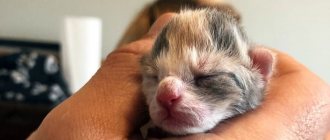- April 19, 2019
- Cats
- Svetlana Funtova
Even breeders with many years of experience are not always able to confidently determine the sex of newborn kittens (photos of babies can be seen in the article). The fact is that in newly born babies, gender differences are rather weakly expressed. However, if finding out the gender of a kitten is an urgent matter, you can do this using one of the methods listed below.
At what age can you tell the difference between genders based on behavior?
Newborn kittens, photos of which can be seen in the article, are no different from each other in terms of characteristic manifestation. They are all cheerful, active, mobile, and develop equally. In some cases, males may weigh more. This is especially noticeable in representatives of large breeds, such as Scottish Folds (photos of newborn kittens are presented below).
It is easy to determine the sex of a pet by behavior at an older age, when its character is formed, puberty sets in, and it becomes accustomed to the environment. This happens at 5-7 months of life. It is enough to observe the animal for some time for everything to become clear:
- Cats are more active and independent. They are not so much interested in family members as in hunting and protecting their own territory. They are fond of playing with small objects and love to watch moving objects outside the window. If another pet appears in the house, the cat will jealously fight for its territory. Among other things, female cats are distinguished by great cleanliness and constantly lick their fur.
- Cats behave differently. They make more contact with people, are friendly and affectionate. Most often, males are lazy; they like to bask in the sun or sleep in a soft bed. However, representatives of some breeds are playful.
When the moment of mating comes, cats mark the territory, which cannot go unnoticed due to the unpleasant smell. The animal's character changes dramatically and, if you don't let it go for a walk, it can scratch or bite its owner. In turn, cats emit loud screams at any time of the day or night, while becoming more affectionate.
How to feed a kitten from birth to one year
When puppies open their eyes after birth
Feeding kittens plays a vital role in their development. Their health depends on it. In the first three days after birth, babies feed on maternal colostrum, then from the 3rd day of life until 2-2.5 months - breast milk.
At 4–5 months, babies are fed five times a day
Complementary foods should be introduced closer to 1 month. It is best to give babies special food for kittens. It is advisable to choose premium and super-premium food or food from the holistic group. Children's meat pates, cottage cheese, and lean boiled meat, which needs to be finely chopped, are well suited as first complementary foods. At 5 weeks, a kitten needs 100–150 g of food per day.
Two-month-old kittens should be given 2-3 pouches per day, as well as a bowl of dry food. They should have six meals a day; if necessary, the frequency of feeding is increased to 7 times a day.
Important! The kitten must drink fresh, clean water, so you need to place a drinking cup next to the bowl.
At 8 months, cats can be sterilized
You need to know well what to feed a 3-month-old kitten: homemade food should be carefully selected. You cannot feed animals regular food from the human table. From natural products, finely chopped boiled turkey, chicken, and beef are suitable.
You should not give your kids fatty meats, pork, lard, or smoked meats. In addition, the diet should not consist only of meat. Kittens need to be offered porridge: buckwheat, semolina, rice, as well as boiled vegetables: carrots, broccoli, zucchini, beets, cabbage. Small cats love low-fat or low-fat dairy products: cottage cheese, sour cream, cream, fermented baked milk. Once a week you can give your kids a boiled egg or some lean boiled fish: cod, haddock, hake.
Having remembered what to feed a three-month-old kitten, you need to learn the list of prohibited foods:
- cow's milk;
- fish and meat with bones;
- smoked, salted, fried foods;
- sweets, baked goods;
- grapes, raisins, potatoes, legumes;
- food from the table.
When choosing what to feed a 3-month-old kitten, you need to decide on the type of diet: natural food or special food. To do this, you need to contact a veterinarian.
It is best to feed kittens wet food in pouches. An additional recipe is known: dry food is poured with boiled water.
The health of the kitten and its entire future life depend on proper nutrition.
Kittens under 3 months old should not be separated from their mother.
Watching kittens grow is very pleasant and joyful. But this is also a very responsible activity, because it will help keep the kids healthy.
How to find out gender at a very early age by external signs
It is easiest to determine the sex of a newborn pet (see photos of kittens in the article) immediately after its birth. The fur at this time is still wet and has not straightened out completely. When the baby becomes furry, it becomes more difficult to determine gender.
Newborn kittens (owners often keep photos of funny babies in albums) have two excretory canals under their tails. The first is for the exit from the rectum, the second is for the exit of the urinary system.
First, you should carefully consider how they are located on the kitten. The distance between these exits in cats is about one centimeter. This is where the pet's scrotum is located. In a female, this value does not exceed three millimeters. These holes differ in shape among different sexes. In cats they are elongated, in males they are round or oval. Simply put, you can see a pronounced “colon” under the male’s tail, while the female has something similar to an inverted exclamation point.
At 10 days of age, cats experience hair growth between the anal and genital openings. In cats, this area is practically devoid of hair. If the pet is a furry breed, it will be quite difficult to determine its gender based on this characteristic, since every day the fur covers the excretory canals more and more.
Your kitten: newborn
- Physical development : Newborn kittens have their eyes closed and ears folded. They will have no teeth, and their gums, nose and paws may be bright pink. They do not yet have a gag reflex or the ability to thermoregulate. The umbilical cord will be attached and fall off on its own between 4 and 5 days of age. The claws will not extend. At this age they can neither hear nor see; they can navigate the world around them only by smell and by seeking warmth and comfort.
- Behavioral Development : Newborns will sleep most of the day. Newborns cannot defend themselves or walk, but can move around by crawling. A healthy newborn will squirm and meow when picked up.
- Average temperature : 35-36 ℃ at birth. It is important to provide a gentle heat source to keep the kitten warm and stable. The kitten's ambient temperature should be between 30-32 degrees Celsius at this time.
- Average weight : 50-150 grams
- Care Information : Newborn kittens are with their mother at all times, as mothers will provide food, cleaning, warmth, and bath support. If the mother is not present, they should be bottle-fed and kitten formula every two hours under the supervision of knowledgeable persons, encouraged to go to the toilet, and maintained at an appropriate temperature.
© shutterstock
How to find out the gender of an animal older than a month
At this time, the genitals of pets are already more pronounced. In cats you can find the foreskin and testicles, in females you can find the anus and a narrow slit. Before deciding on the choice of a pet of a specific gender, they look under the tail to determine it.
The use of this method for recognizing the gender of a newborn kitten (photos of babies are presented in the article) is considered the most reliable. The probability of correct identification is 90%.
Three months
At the age of three months, the kitten already knows its name.
A fully formed personality with its own disposition and character, it is almost useless to re-educate a child. A three-month-old baby calmly navigates the apartment, knows where the bowl and tray are, and responds to his name and the owner’s call. It's time to give it to new owners.
How to hold a kitten
To avoid injury and stress in the newborn, a visual inspection is carried out as follows:
- The kitten is taken in the palm of your hand and warmed up for several minutes, allowing it to calm down.
- Then carefully transfer it to a dry, soft surface on the tummy or back.
- Then they carefully lift or move the tail to the side and examine the genitals.
If you scratch or massage the animal's rump a little, it will instinctively raise its tail. You should not disturb the kittens by carrying out this procedure if their mother is restless, otherwise she will begin to drag the babies from place to place, trying to cover them. If it was not possible to immediately determine the gender, it is better to try again the next day. Kittens quickly become hypothermic without maternal warmth, so examination should be done as quickly as possible. As a last resort, the genitals can be photographed, and then the gender can be determined without haste. You can see what newborn kittens look like in the photo below.
Pictures of a LOT of kittens
Two white kittens and a red kitten are sitting on a wicker plate
Five gray and white kittens sitting on a wooden chair
Twelve cute kittens sitting in a wicker plate
Five red kittens and one gray kitten are sitting in a wicker basket
Two chocolate kittens and one gray kitten are sitting on a spit
Three little white kittens fit in one hand
There are four gray kittens lying in a crib, and a fifth one is standing next to them.
Seven kittens sitting in a crib in the corner
What not to do
Photos of newborn fold-eared kittens are touching pictures that you can look at endlessly. Despite this, there is no need to disturb the kids again. You should also follow some rules:
- You should not tear your pet away from its mother while feeding.
- You cannot lift a kitten by its tail.
- If possible, you should try not to touch the babies until they reach three weeks of age. Some cats, sensing a foreign smell, abandon the baby.
- It is prohibited to put pressure on the genital area during the examination.
Photos of Cornish Rex kittens
The Cornish Rex is an exquisite breed of cat with a very soft and curly coat that embodies the most striking features of the little fidget. His playfulness and curiosity will not let you get bored for a minute!
We recognize affiliation by face and DNA
You can recognize the sex of newborn fold-eared kittens (photos of these fluffy pets are presented below) by carefully examining their face and body. This method is more suitable for experienced owners. Those who are dealing with representatives of the feline family for the first time may make a mistake.
Females have a more elegant, elongated and narrowed muzzle. In turn, cats are endowed with a large head and a muscular body. The disadvantage of this method is that it is only possible to determine sex in adult cats, when the characteristic features are more pronounced.
Modern medicine makes it possible to accurately determine the sex of kittens at any age using a DNA test. Conducting this research will require significant financial expenses. However, if the animal has reached three months of age since birth, there is no need for testing.
The study can be carried out in a veterinary clinic equipped with appropriate equipment. The DNA testing method is used primarily by owners of breeding animals who breed and sell them. During the test, a sample is taken from the inside of the kitten's cheek. As a result, it is possible to identify not only the gender of the pet, but also its susceptibility to certain genetic diseases.
Photos of Himalayan kittens
The Himalayan cat is a blue-eyed, long-haired color-point creature obtained by mating Persians with representatives of the Siamese group. Some felinological systems register representatives of this family as an independent breed, others – as a variety of Persian cats.
How to find out gender by coat color
The color of a cat's baby can also indicate its gender. In this case, newborn kittens can be distinguished by gender (photo below) taking into account the following features:
- The tortoiseshell color combines three colors - black, white and red. As a rule, its owners are female representatives of the cat family. This fact is due to the transfer of color by the X chromosome, and for the manifestation of all three tones, a pair of them is needed. Only cats have them in such quantity; males have only one X chromosome. In nature, tortoiseshell cats are found only if they are susceptible to rare genetic diseases.
- Mainly males are distinguished by their red color. If a born kitten has this color, there is a 99% chance it will be a boy, but there are exceptions to the rule.
If we talk about the thickness of the fur, it differs only in the location of the genital organs - males have much more of it, but in females it is almost completely absent.
Cuddling kittens
One of the images I came across while searching for cuddling kittens shows two felines, one standing upright with his front paws wide open and looking at the other kitten across from him, who appears to be sitting nonchalantly.
You might think that a kitten standing upright really wants to hug its furry friend. In fact, a kitten standing on its hind legs is using the other as hunting practice, while a sitting kitten is preparing to defend itself.
While this obviously seems like a joke, it perfectly illustrates the very human perception of cat behavior.
There are a lot of situations when you see cats hugging, and it brings delight.
They hug, kiss and even look at each other with loving eyes. Sheer cuteness. ... It turns out that cats are so similar to people.
Animal size and folk methods of determining ownership
You can often find out the gender of a newborn kitten (the photo below demonstrates this well) by size and weight. As a rule, females are smaller than males, more graceful and graceful. However, based on these signs alone, it will not be possible to determine with one hundred percent probability the gender of a newly born pet.
One of the popular methods says that if a kitten looks around warily and is rather indecisive, it is most likely a female. Cats, on the contrary, are characterized by courage and self-confidence. However, this rather depends on the nature of the animal.
Another method of determination is based on the pet’s habits. A bowl of food is placed in front of him and his behavior after feeding is observed. If the tail is raised up, it is a cat; if it is modestly lowered, it means a cat.
Habits as a way to determine gender
Another way to recognize where a cat is is from habits, since a living creature has only its own character traits. In this regard, it is possible to find out the gender of a pet using the following criteria.
Cats:
- Indifferent to the owner.
- They behave independently.
- Active hunters.
- They fiercely protect their personal space and are active in games.
- Very clean.
- If a cat has marked its territory, it can also scratch objects surrounding this area.
Cats:
- They are carefree and reach out to their owner, happily making contact with him.
- Affectionate.
- Lazy, and mostly sleep or eat.
- They devote little time to self-care.
- The cat is marking its territory. His urine has a strong pungent odor.
These features are generalized, and the animal may have individual character traits.
other methods
If it was not possible to distinguish newborn kittens by gender (see photo in the article) while they are very small, you should wait until the babies are a little older. In the end, if a new family member has won the heart of the household, what difference does it make whether he is a male or a female? Photos of newborn kittens - Persian, Siamese or any other breed - prove that it is impossible not to love these babies. If gender is of fundamental importance, you can try to determine it in the following ways:
- A tricolor kitten is most likely a female. Cases of the birth of tortoiseshell cats are considered an anomaly. In addition, they end up being infertile.
- It is extremely rare to find a red cat; as a rule, they always turn out to be cats.
- Male representatives of this family behave unceremoniously, are very active and lively.
- Cats are more careful, calm and leisurely.
- Males have sharp and large features, while females have a more subtle and smooth muzzle.
- Cats have a narrower chest and thinner paws. Males, on the contrary, are larger and stockier.
- The urine of cats has a sharp and unpleasant odor, unlike cats.
Of course, many of the listed methods for determining gender raise some doubts. They are indeed not very accurate, however, they can be used in conjunction with other, more reliable methods.
Beautiful cats with kittens
And so, you decided to purchase a valuable treasure - a kitten.
It doesn’t matter whether you adopted a cat from a nursery, from a friend, picked it up on the street, or adopted it from an animal shelter - from now on, your pet needs your support and education. Remember that this is a living, defenseless creature, whose life and health completely depends on you. Usually kittens “get there” and are scared of a new, unfamiliar place. Therefore, it is important to follow several rules. which will help the little creature quickly adapt indoors, and help you find an approach and make friends with a new family member.
When you bring the cat home, let the animal calm down and look around. This is a lot of stress for a kitten - a new place to live. Here he sees a new large space, strange smells, scary sounds and strangers. By taking a kitten from its mother cat, you become its mother, and not just its owner.
In the first days, try to limit the kitten in space, place it in one room on the first day, let it get used to it, sniff everything, and calm down. In the same room, put him a bowl of water and food, a tray, and, if available, a special house or place to sleep.
Almost all kittens are very curious. Starting with one room, it will be easier for the baby to get comfortable in an unfamiliar room, and after a week or two he will begin to explore other rooms on his own. Be kind and affectionate with your pet, the kitten will quickly get used to its new owners.
In the very first days of a kitten’s arrival in your home, try not to squeeze it too much, especially against its will. Kittens love affection, but the little creatures are very shy. Let your pet get comfortable, and then when he gets used to his home a little, finds a place for himself, lies down, you can pet him or play with him, for example, by buying a toy for kittens.
The beautiful cats and kittens in the photo will undoubtedly delight you and make you want to buy yourself a small pet.
By deciding to buy a kitten, you will become another happy owner of a graceful animal.
Development in the first week of life
Newly born babies weigh no more than 100 g, but already in the first week of life they practically double their weight. Too much or too little of this value directly affects the development of the animal, so it is important to provide careful care and weigh it regularly.
After 3-5 days, the kittens’ umbilical cord falls off, and the mother cat takes care of it independently. To exclude possible inflammatory processes, it is first recommended to lubricate it with a weak manganese solution.
Newborn kittens (photo below) are born blind and deaf. Deafness disappears already on the fifth day, vision appears only after three weeks. It is very important to properly arrange a place for a cat that has given birth, so that babies can easily find her by smell.
Development in the first weeks of life is rapid. It is at this time that kittens receive a complex of necessary vitamins and minerals from their mother’s milk to form a strong immune system.
Ages from four to seven months
By this time, growth slows down, weight and size depend on the breed. The baby is cheerful and active, as at an earlier age, but his habits are more similar to an adult, sedate animal. The four-month-old kitten is still just as cute and cuddly, but no longer resembles the harmless little fluffy ball it used to be.
In case of danger, he knows how to stand up for himself. The replacement of baby teeth with permanent ones begins.
Five to six months is adolescence. From a cute round creature, the baby turns into a lanky, awkward, poorly formed creature: he is no longer a child, but he grows and grows into an adult cat.
At seven months, most individuals enter the stage of sexual maturity: males begin to mark their territory, females may appear in their first heat (although this is not necessary, much depends on the breed and individual characteristics of the body).
What happens from the second to the fourth week
At the initial stage, the kitten's weight increases to 250 g, he begins to hear the call of his mother and the meowing of his brothers and sisters. At this time, the active development of the animal’s character begins.
In the third week, the babies' eyes open, but their vision is still quite poor. All organs of smell and touch continue to form, the skeleton is strengthened, and teeth appear. The jaw will not fully develop until two months of age. At this time, you can take the kittens in your arms, accustoming them to human care.
By the end of the fourth week, the animal already has 26 teeth, is able to move independently on straight legs and can switch to complementary feeding. During this period, changes in appearance occur less clearly, the kitten continues to grow and gain weight.
Photos of Neva masquerade kittens
The Neva Masquerade cat is a beautiful and noble animal, famous for its luxurious “fur coat”. She is cheerful, quick-witted, curious, and very affectionate and friendly.
About three weeks after birth, it is time for socialization, when the offspring begins to independently explore the environment. This is when the mother begins to encourage curiosity. However, she still worries, so you can hear a rather strange sound from her when she calls out to those who have wandered too far.
By four weeks, kittens should be fairly stable on their feet. Then their mother begins to wean them off milk. By six weeks they will begin to play, jump and climb.
Many experts recommend exposing kittens to people between four and six weeks. You need to pet them gently and calmly enough so that they get used to your touch.
Development from month to year
Starting from this age, the gastrointestinal tract of kittens is actively developing; already in the eighth week, weaning from the mother occurs and the transition to independent food five times a day occurs. Deworming is carried out.
At three months, pets begin to look for a new owner. Parting with the mother and other kittens is not so painful if you devote enough time to the baby. Repeated deworming is carried out and the kitten is trained to use the tray.
Up to six months of age, the animal continues to eat kitten food. At six months, the pet’s teeth begin to change, and he is transferred to three meals a day. According to experts, this time is optimal for castration. The third deworming is performed.
At seven to eight months, cats continue to develop self-care skills. At nine months of age, the pet is considered fully formed; it continues to grow and gain weight. It is important to monitor the condition of the animal’s nails and cut them in a timely manner. During this period, they begin to gradually transfer the pet to food for adult cats, gradually mixing it into their usual food.
By the age of one year, the pet has completely completed its development. He is accustomed to go into a litter box or outside, has all the necessary skills of an adult animal, and has an established and formed diet. It is important to visit a veterinarian promptly for vaccinations and monitoring the health of your pet.
Stages of kitten development by month
When kittens open their eyes: how many days after birth
Once born, kittens grow and develop during the first year of life. “Coming of age” in cats occurs at 12 months. At each stage of growth, the baby requires appropriate care: nutrition, weight control, medical examination, vaccinations, etc.
Stages of development:
- Prenatal period - during the cat's pregnancy.
- Neonatal - from birth to 10 days.
- Transitional - from the 10th to the 20th day of life.
- The period of socialization is from the third to the tenth week of life.
- Juvenile - at 2.5–5 months.
- Puberty occurs between 5 and 12 months.
Immediately after birth, every day of the baby’s life is of great importance. Starting from the age of 7 days, the count goes into weeks. When the baby reaches the age of 2 months, developmental stages are counted in months. A six-month-old kitten can already be called a teenager. He continues to grow and develop rapidly and becomes an adult cat closer to the age of one year.
First 7 days of life
You need to take care of the health of kittens when they are still living in the womb. A pregnant cat needs to be well fed and protected from stress. It is advisable to equip her with a warm nest where she can rest. A year before pregnancy, the cat must be vaccinated.
Week-old babies are growing rapidly
Kittens are born blind and deaf. Each baby weighs about 60–100 grams. At this time, the baby’s nervous system continues to form. For the first 7–10 days of life, they sleep and suck their mother's milk. In the first three days, babies receive colostrum - a nutritious fluid containing antibodies to all diseases.
For your information! Colostrum is unique and irreplaceable: with it, kittens receive not only food, but also their first vaccination. It is very important that babies eat colostrum: it strengthens their immunity.
The mother cat spends all the time with her children, only leaving occasionally to eat. In the first days after birth, kittens navigate only by smell and touch: they can find their mother at a distance of 60 cm. They can squeak, and a little later they learn to purr.
Newborn kittens have reflexes responsible for their vital functions:
- Sucking - allows you to feed on mother's milk. If this reflex is impaired, the kitten may die.
- Perineal - responsible for urination and defecation. To stimulate it, the cat licks the kittens' tummies. If the babies are orphaned, then this should be done by the owner who feeds the pets.
- Cover reflex.
The kitten begins to hear 5-8 days after birth. But despite this, he still does not know how to navigate by sound. It is necessary to place the kittens in a quiet room so that they are not frightened by noise.
If a kitten refuses to suckle breast milk, he needs to be given an injection of Gamavit or Aminovit. You can put 2 drops of Travmatin in your mouth.
Week-old kittens eat only their mother's milk. At this age, they already hear, but do not see yet. They must be weighed twice a day and weight gain must be constantly monitored.
Important! Violation of the sucking reflex is a condition that threatens the life of the baby. A common cause of this is a cleft palate (cleft palate). The kitten tries to suckle, but the milk pours out through the nose. In such cases, the baby is most likely doomed.
Second week of life
On the 10th or 14th day of life, kittens' eyes open. At this age, all babies have blue eyes. Their color changes closer to 3 months.
Kittens at 2 weeks weigh almost twice as much as at birth - about 200–250 g. You need to carefully monitor their diet and weight. At this age, they still feed on their mother’s milk and need her care.
Two-week-olds open their eyes and ears
You can see how adult cats trample a soft blanket with their paws and purr. This indicates that the cat is happy and content. This reflex has been preserved since childhood, when newborn kittens knead their mother’s belly to get milk.
Third week of life
The musculoskeletal system of kittens gradually strengthens, and three-week-old babies become more active: they begin to crawl over each other and begin to play. Closer to the 20th day of life, kittens stand on 4 legs and try to walk. Their weight increases to 250–350 g. At the same time, they begin to teethe.
Kittens develop a feeling of attachment to their mother and to each other. In the same way, they become attached to the owner. The cat begins to teach the kids.
Fourth and fifth weeks of life
At the age of 1 month, the kitten moves confidently, sees and hears well, and loves to play. He has already grown 26 baby teeth, which will be replaced with permanent ones over the next 6 months. It is necessary to introduce complementary foods into their diet: canned food for kittens, boiled meat, cottage cheese. Kids learn to lap up water or milk from a saucer. The weight of a one-month-old kitten is 350–450 grams.
The period of socialization begins when the baby learns to interact with the world around him: with his mother, with brothers and sisters, with toys, with owners, with household objects. At this age, small cats are very active and playful. The owner must take care of the safety of pets.
At 1 month, kittens know how to wash themselves and love to play.
At 5 weeks, kittens can wash themselves and go to the litter box. Gradually they switch to solid food and drink breast milk much less often. They need to be weighed every day.
Two months of kitten life
A mother cat feeds her babies with breast milk for up to 2 months. Then they completely switch to the adult diet. Babies vitally need the whole complex of vitamins and minerals. At the age of 8 weeks, you need to take the kittens to the veterinarian so that he can prepare a diet for them, drive away worms and give them vaccinations. 3 weeks after the first vaccination, they are vaccinated again: this will protect the animals’ immunity for a long time.
Two-month-old kittens need to be petted and stroked frequently. During this period, their behavior changes and more activity appears. They will need toys and space to run and play.
Interesting fact! Boys grow faster than girls.
Three months of kitten life
Up to three months, the development of kittens varies from week to week. At this age, the claws become stronger and the weight reaches 1.3–1.5 kg. Blue eye color changes to green, yellow, amber or any other color that will remain forever. Bones, muscles, joints and tendons become stronger and stronger, so pets can run and jump for a long time. Kittens become independent, so at 3 months they can be separated from their mother and placed in good hands.
A three-month-old kitten comes up with different games and fun. He can climb up curtains, play with any objects, run and jump. It is very important that the owner finds mutual understanding with a child of this age. Both the upbringing and safety of your furry pet depend on this.
At 2 months the first vaccinations are given
A caring owner should know what to feed a 3-month-old kitten. Special food for kittens is perfect. You can give boiled meat, cottage cheese, pates. Babies are fed 5-6 times a day, a single serving should be 100 g.
Fifth month
At this age, permanent teeth grow in place of baby teeth. Favorite fluffies gain weight up to 1.8–2 kg. They need to be fed 4-5 times a day and weighed weekly. It is advisable to combine dry and wet food intended for kittens up to one year old.
Sixth month
In six-month-old animals, hormonal levels change and the process of puberty begins. They reach the size of an adult animal. It is necessary to give the kittens an anthelmintic again and take them to the veterinarian.
At this age, you can switch your pets to three meals a day. It is still necessary to feed babies baby food, because it contains many useful substances that a growing body needs.
Table No. 1. Kitten weight by week (medium sized cats)
| Age | Weight |
| Newborns | 70–130 g |
| 1 Week | 140–285 g |
| 2 weeks | 225–400 g |
| 3 weeks | 285–500 g |
| 1 month | 500–750 g |
| 2 months | 1–1.5 kg |
| 3 months | 1.7–2.3 kg |
| 4 months | 2.5–3.6 kg |
| 5 months | 3.1–4.2 kg |
| 6 months | 3.5–4.8 kg |
After six months, the growth rate slows down slightly, and kittens gain an average of 100 g per week.
Seventh month
At 7 months, kittens begin to molt. At this time, it is necessary to comb the coat every day with a furminator or comb. Cats that shed often lick themselves, which causes fur to get into their stomachs, causing them to vomit. The formation of hairballs in the stomach is extremely dangerous, so cats need to be combed.
Attention! Timely vaccination will save kittens' lives.
After 3 months and before the first vaccination, babies' immune systems weaken, so they can become infected with an infectious disease. If your kitten's eyes are festering, or if he has become lethargic, you should immediately contact a veterinary clinic.
Eighth month
By this age, kittens have already grown enough and look like adults. Animals need to be sterilized at 8 months. You must first be examined by a veterinarian. An animal can be sterilized no earlier than a month after vaccination.
At 3 months, eye color changes, you need to switch to adult food
Development from 9 months to a year of life
This is the final period of childhood. Young cats at 9–12 months do not grow as quickly as before. Active, curious, playful pets still love to run and frolic.
Height, weight and development depend on the size of the animal, including the breed. It is necessary to take these nuances into account. The breed, which came to us from Scotland, has several distinctive features. The most noticeable of these is the floppy ears. All Scottish cats are born with straight ears. Only 18–20 days after birth can fold-eared kittens be recognized.
Big cats - British and Maine Coons - weigh a little more than others.
Table No. 2. Weight of Maine Coons, Scottish and British kittens by week
| Age | Maine Coons | British | Scottish |
| Newborns | 120–160 g | 60–140 g | 60–140 g |
| 7 days | 180–260 g | 110–260 g | 110–260 g |
| 2 weeks | 280–360 g | 150–400 g | 140–400 g |
| 3 weeks | 420–600 g | 210–630 g | 200–630 g |
| 1 month | 560–750 g | 250–740 g | 240–740 g |
| 2 months | 1.1–1.5 kg | 450–1700 g | 400–1700 g |
| 3 months | 1.7–2.3 kg | 1–2.5 kg | 1–2.5 kg |
| 4 months | 2.7–3.8 kg | 1.7–3.9 kg | 1.7–3.9 kg |
| 5 months | 2.9–5.5 kg | 2.2–4.3 kg | 2.2–4.3 kg |
| 6 months | 3.2–6 kg | 2.3–5.4 kg | 2.3–5.4 kg |
| 7 months | 3.5–6.5 kg | 2.4–5.6 kg | 2.4–5.6 kg |
| 8 months | 3.8–6.9 kg | 2.5–6 kg | 2.5–6 kg |
| 9 months | 4.1–7 kg | 2.5–6.4 kg | 2.5–6.4 kg |
| 10 months | 4.2–7.7 kg | 2.5–6.7 kg | 2.5–6.7 kg |
| 11 months | 4.3–8 kg | 2.5–6.8 kg | 2.5–6.8 kg |
| 1 year | 4.5–9 kg | 2.5–7 kg | 2.5–7 kg |









